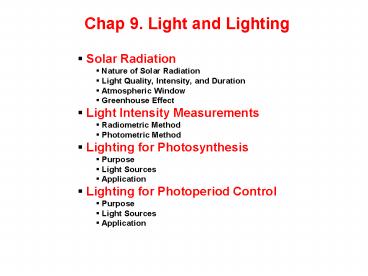Chap 9. Light and Lighting - PowerPoint PPT Presentation
Title:
Chap 9. Light and Lighting
Description:
Chap 9. Light and Lighting Solar Radiation Nature of Solar Radiation Light Quality, Intensity, and Duration Atmospheric Window Greenhouse Effect Light Intensity ... – PowerPoint PPT presentation
Number of Views:124
Avg rating:3.0/5.0
Title: Chap 9. Light and Lighting
1
Chap 9. Light and Lighting
- Solar Radiation
- Nature of Solar Radiation
- Light Quality, Intensity, and Duration
- Atmospheric Window
- Greenhouse Effect
- Light Intensity Measurements
- Radiometric Method
- Photometric Method
- Lighting for Photosynthesis
- Purpose
- Light Sources
- Application
- Lighting for Photoperiod Control
- Purpose
- Light Sources
- Application
2
Concept of Light
Radiation A process of emitting energy in the
form of electromagnetic waves or
particles (photons). It ranges from cosmic rays,
gamma rays, x-rays, UV lights, visible light,
to infrared and radio waves.
Light That portion of radiation perceived or the
light-restricted portion of spectrum Irradiation
A process by which a surface is illuminated or
irradiated (i.e., irradiation of flower buds
with x-ray to induce mutation).
3
The Solar Radiation
Visible Light Spectrum
4
The Influence of Atmosphere
Courtesy NASA
5
Atmospheric Windows
The interaction of electromagnetic radiation with
atmosphere allows only light in certain waive
length regions to penetrate the atmosphere well.
These regions are called atmospheric windows.
The filtration of radiation is largely due to
CO2, zone, water vapor in the atmosphere.
http//csep10.phys.utk.edu/astr162/lect/light/wind
ows.html
6
Composition of the Visible Light
Source NASA
7
Spectral Ranges of Visible Lights
- Violet 0.4 - 0.446 µm
- Blue 0.446 - 0.500 µm
- Green 0.500 - 0.578 µm
- Yellow 0.578 - 0.592 µm
- Orange 0.592 - 0.620 µm
- Red 0.620 - 0.7 µm
- Infrared 0.7 - 0.9 µm
8
Light Quality
- What does it mean?
- What spectrum of light does it involve? (Red,
blue, green, orange, or infrared lights, etc.) - 2. Measurements
- a. Wave lengths distance from peak to peak
- or valley to valley in units of nm or µm
- µm 10-3 mm
- nm 10-6 mm
- Å 10-3 nm
- b. Wave number number of waves per cm of light
(number/cm) - c. Frequency number of cycles per second
(cycles/sec, cps) - Hertz (Hz) 1 cycle/sec
- Mega Hz 1 million Hz
9
Light Intensity
- 1. What does it mean?
- How much irradiated on the surface (Quantity)
- 2. Radiometric measurements
- a. Light intensity measured in terms of power
of radiation on a unit surface area - Power energy/unit time
- Intensity power/unit area, energy/unit area
per unit time - b. Measurement units Joules cm-2 sec-1, watts
cm-2,BTU ft-2 hr-1, kcal cm-2 hr-1 - c. The shorter the wave length, the more the
energy available. - 3. Radiometric measurements
- a. Light intensity expressed in terms of
illuminance or how bright the light is (visible
radiation only) - b. Measurement units Foot candles, lumens,
lux, µmol m-2 sec-1 - c. Relationships 1 lux 1 lumen m-2
- 1 foot candle 10.76 lux
- 4. Factors affecting light intensity
- a. Moisture in the air No. of clear
days in January 70-80 in AZ, 30-40 in NY - b. Topography
- c. Pollutants in the air (PAN, SO2, NOx,
etc.)
10
Duration of Light
- 1. What does it mean?
- How long the light was on
- 2. Factors that affect light duration
- a. Time of the year (seasonal variation)
- b. Latitudes (both northern an southern
hemisphere) Fargo 56.5 N - 3. Photoperiod responses
- a. Long day plants (short night plants)
- Requires days longer than 16 hours to bloom
- Aster, petunia, potato
- b. Short day plants (long night plants)
- Requires days shorter than 13 hours to bloom
- Chrysanthemum, poinsettia, kalanchoe
- c. Mechanism of responses
- Phytochrome system
- P660 red light absorbing form
- P730 far-red light absorbing form
11
Influence of Photoperiod on Flowering
12
Spectral Distribution of Various Lamps
Spectral Distribution of Various Lamps
13
Spectral distribution of selected fluorescent
lamps
14
High Light Intensity Discharge (HID) Lamps
Mercury Vapor Lamp
High Pressure Sodium Lamps
Mercury Lamps
Metal Halide Lamps
15
Lighting for Photosynthesis
16
Lighting for Photosynthesis Quebec, Canada
17
(No Transcript)
18
(No Transcript)
19
Influence of Photoperiod on Poplar Tree
Left - Short Day Grown Right - Long Day Grown
20
Black-Clothing to Shorten Day Length
21
Automation of Shading for Photoperiod
ControlBergens Greenhouse, Detroit Lakes, MN
22
Cut Chrysanthemum ProductionSalinas, California
23
Day Length Control for Cut Chrysanthemum
Production in Florida
24
Year Round Production of Potted Mums Palisade
Greenhouse, Colorado
25
Black cloth canvas is used to cover plants during
short-day treatment































